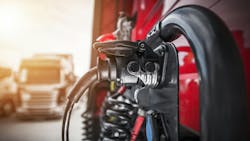EV diagnostics: A critical part of electric vehicle management
This is the final part of a three-part series on fleet diagnostics. You can read Part One here and Part Two here.
The development of electric trucks and components represents a considerable step for fleets focused on achieving sustainability initiatives and meeting requirements to adopt zero-emission vehicles.
"Remote diagnostics are very important with EVs," said Patrick Wallace, Peterbilt marketing manager for zero-emission and connected trucks. "Where EVs differ is that they are very efficient vehicles that must do a lot of work with a small amount of energy."
"Weather and things like auxiliary usage state of charge can greatly affect the range of an electric truck," he continued. "That means fleet managers need to be empowered to watch their energy usage for route planning and optimization, so those are important remote diagnostic features we are planning to add with our future EV product releases."
At Carrier Transicold, remote monitoring is a part of zero-emissions TRU development. "While monitoring temperature is one capability, telematics from the TRU can also help fleets with emissions compliance by providing documentation of idling avoidance," related Scott Blair, senior digital program manager, Lynx Fleet Telematics Carrier Transicold, Truck/Trailer/Rail Americas.
See also: No juice, no EVs: Utilities weak link in fleet transition
"The Lynx Fleet system will also monitor battery state of charge so fleets can develop a charging plan that's efficient and maximizes the benefits of zero-emissions TRUs," he added. "TRU telematics can also support fleet operations more broadly, helping to capture data on battery voltage, dwell time, and maintenance matters related to EVs."
Mack's senior strategy and sustainability manager, Patrick Brown, considers EV monitoring essential. "Through remote monitoring, we will be able to help our customers get the best performance out of their EVs."
"With telematics on EVs, we can understand usage behaviors, patterns, and specific applications and provide recommendations to help extend battery life and ensure batteries are optimized to operate at peak performance," said Magnus Gustafson, VP of connected services, Volvo Trucks North America. "Our customers are still learning how to best operate these new vehicles, so by aggregating data to identify trends, patterns, and outliers, we can consult with fleets to make best-practice recommendations."
About the Author

Seth Skydel
Seth Skydel, a veteran industry editor, has more than four decades of experience in fleet management, trucking, and transportation and logistics publications. Today, in editorial and marketing roles, he writes about fleet, service, and transportation management, vehicle and information technology, and industry trends and issues.
